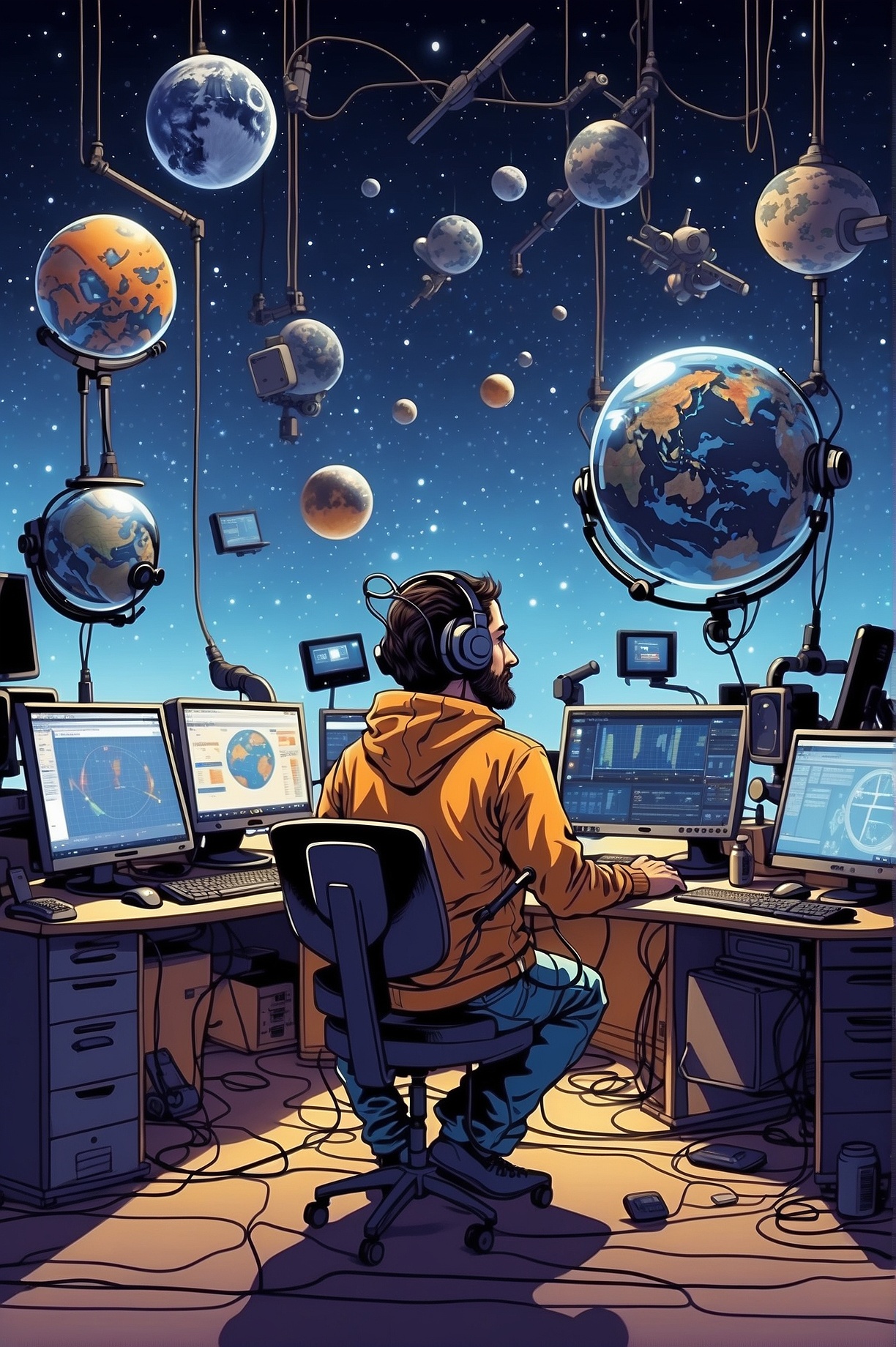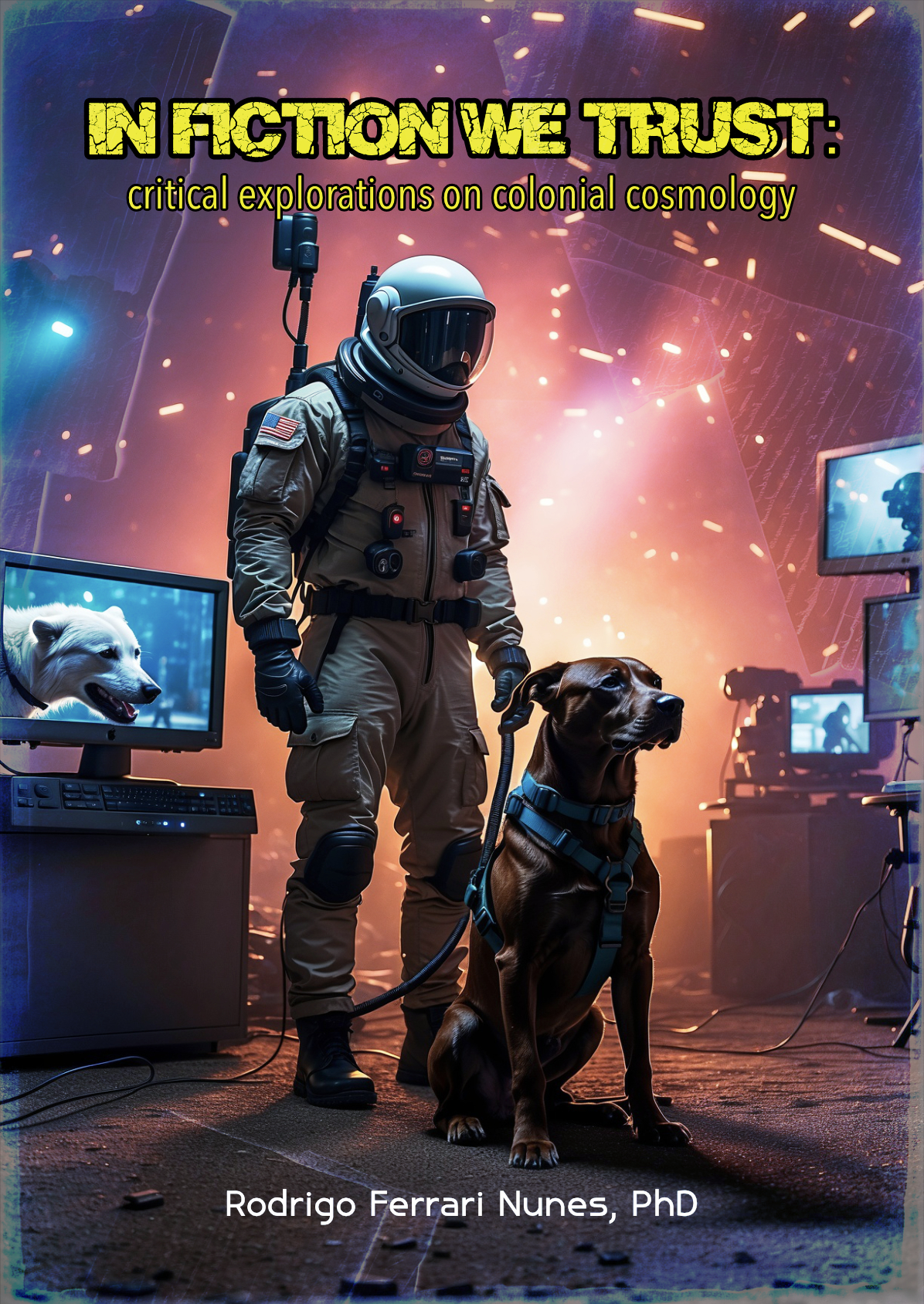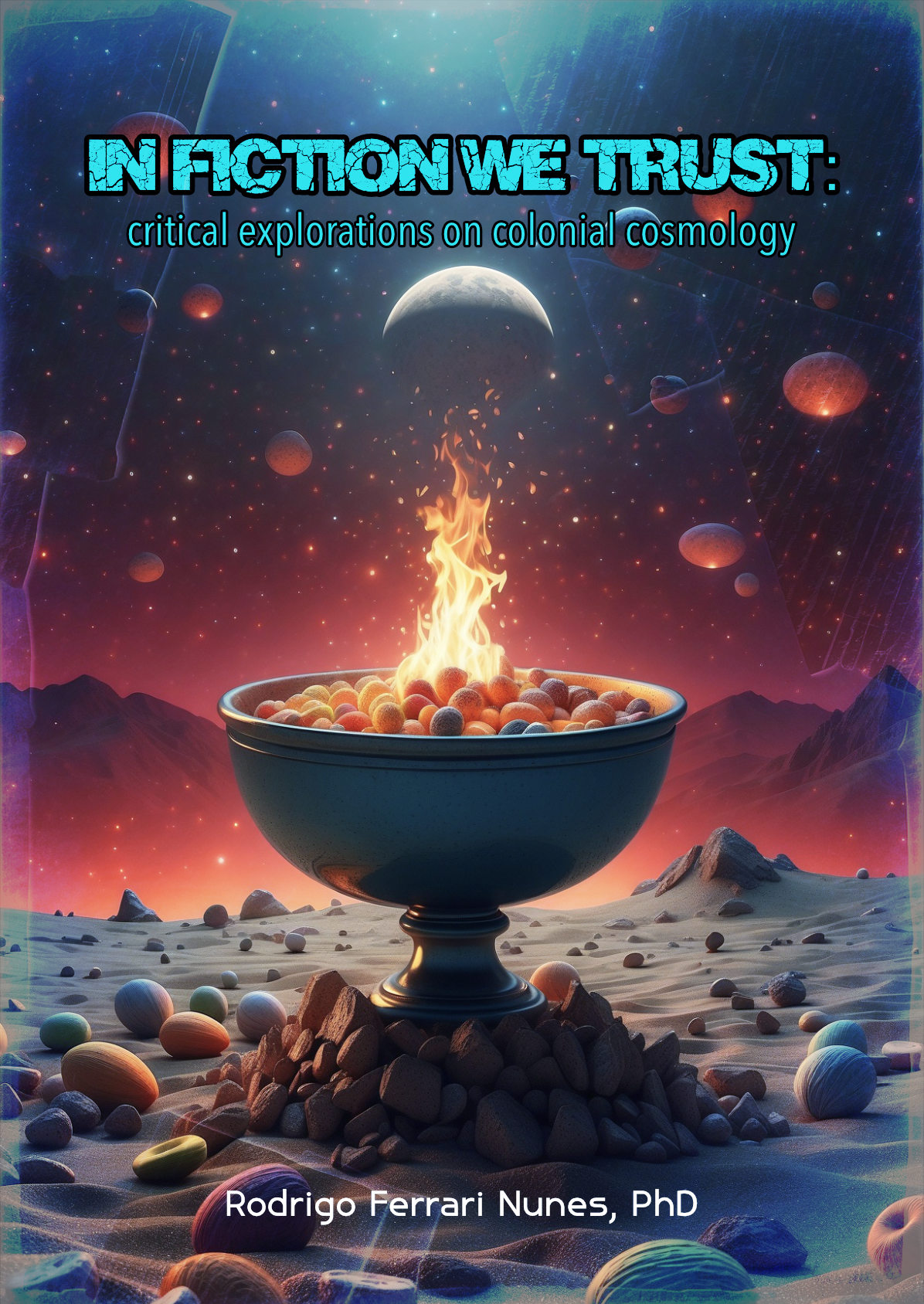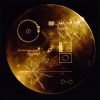
EXOPLANET ANTHROPOLOGY
In this chapter, we examine the work of Lisa Messeri, an anthropologist who lived among space believers. We focus on material from her ethnography among people who spend extended periods of time in the Utah desert imagining they are doing research on Mars.1 One key feature of her ethnographic subjects is that they believe they are studying exoplanets remotely, from the Earth, and without any realistic prospect of ever visiting these imaginary places.
As I have demonstrated in my 2-part presentation, How to Tame Your Astrophysicist, the alleged data that supports the notion that exoplanets exist comes from twinkling pixels and a just-so story.2 In other words, if a star twinkles from time to time, or seems to blink periodically, believers assume that it must be because a planet is passing in front of it, in the exact angle that would allow astronomers on the Earth to see it.
Compelled by the many JPL posters promoting interstellar tourism, people are led to believe that these are places with a wild variety of features and contribute to inventing and imagining stories about them.3 Messeri’s work requires an impressive balancing act: how to explain what self-ascribed exoplanet scientists imagine without offending them by pointing out the obvious fact that their hopes are fictional. Clearly, people who claim to be exoplanet explorers will never step off this Earth. All arguments that could be made to the contrary rest on hopes, assumptions, and fiction. Thus, Messeri strives to represent her subjects’ convictions as they described them. In this way, she deflects to the reader the responsibility of reaching conclusions.
1 Messeri, 2016 and 2017.
2 Ferrari-Nunes, 2021.
3 See a collection of JPL posters here: https://www.jpl.nasa.gov/galleries/visions-of-the-future.

MAKE-BELIEVE SIMULATION CULTURE
For Messeri, exoplanet believer culture is a good way to exercise the imagination, wondering about other worlds. Her rhetorical strategy reflects the patterned minds of her subjects as a mixture of imagination and storytelling based on unverifiable beliefs. Yet, such beliefs are often stated with fanatical conviction and certainty. Belief-based imagination is the only proof they require and provide, as their claims are largely unverifiable. This is also true of astrophysics in general, a form of storytelling utterly dependent on abstract math and computer simulations. Under colonial cosmological control, most people are unable to recognize this simple fact. They are caught in webs of authority that wrap up a subject they believe to be beyond their grasp. In reality, it only takes a few years to become indoctrinated in astrophysical lore. A barrage of dull mathematical equations also serves to intimidate potential critics. They are meant to impress those who believe that numbers are the best way to describe nature.
We find an extreme example of this naïve view in the works of Neil deGrasse Tyson, who claims that mathematics can make unbiased, superior humans. He asks us to “imagine how different the world would be if thinking mathematically about human affairs was normal and natural.”4 As a typical materialist, he continues by imagining how mathematical training should affect human physiology: “Scientists are human too, but the extensive mathematical training slowly rewires these irrational parts of the brain, leaving us a bit less susceptible to exploitation.”5 By reducing their minds to the absurd, people like Tyson subscribe to the idea that humans are machines that work according to “personal equations of risk and reward.”6
People who share Tyson’s naïve view of reality are trained to ignore the fact that numbers, equations, and the way they are manipulated, are inextricably linked to stories and concepts, creations that could never be unbiased. Curiously, they tend to see their own self-professed bias towards reductionist outlooks as a non-bias. For us, adopting George Orwell’s terminology, their belief is yet another example of hows newspeak dominates minds reduced through doublethink concepts.
4 Tyson, 2022, ch. 5.
5 Tyson, 2022, ch. 5.
6 Tyson, 2022, ch. 5.

SCIENCE FICTION CONFINEMENT
Messeri’s way of weaving her stories about space shows that she is confined within NASA’s narrative and cannot transcend it by thinking critically. For instance, she trusts blindly in the words of astronauts, believing their alleged cosmic experiences are undeniable. That is, Messeri does not possess the basic technical knowhow necessary to demonstrate how NASA produces its space exploration stories. However, she still questions exoplanet lore as a mythology that subjects actively imagine as some inevitable future reality. Everything they imagine, not surprisingly, refers back to science fiction. They chase intangible dreams. Since they know intuitively that their dreams will never be realized, they seek the comfort of returning again and again to their favorite science fiction novels and films. As Messeri points out, “knowledge of science fiction” often serves as “an explanatory device” for participants of NASA-funded Mars exploration simulations.7
Messeri lived with a crew of exoplanet believers whom, as part of a NASA project, pretended to be on Mars while living in a habitat or hab, placed in the Utah desert.8 The influence of science fiction among the participants was both overwhelming and undeniable. As Messeri describes:
“Narratives of science fiction spill over into the library and DVD collection amassed at the hab over the years. Most crews reserve the evening for entertainment: watching movies on laptops or, as my crew did, bringing a projector for a more theatrical experience. Crews report mostly watching science fiction, ranging from classics like 2001 and Dune to the more recent fare of Starship Troopers and Galaxy Quest. There is a healthy amount of Mars-based films, like Total recall, Mars Attacks, and Red Planet. Shortly after the one and only season of Firefly — a television show that fused western frontier and sci-fi tropes — was released on DVD, crews frequently evening viewing of episodes (my crew included).” 9
Messeri notes that astronomers who search “for an Earth-like planet elsewhere in our galaxy imagine the significance of such a discovery.”10 These astronomers are imagining a discovery. In other words, they project assumptions into fictional futures. They are not making any concrete discoveries. Amazingly, they work in a field in which you can simply imagine a discovery and get away with it. For them, all sorts of present fictions are future realities. They are deeply invested on this claim simply because they have devoted their own time to imagining it, and have been paid for it. This makes it impossible for them to turn around and admit the fact that their beliefs are based on fictions. They would look ridiculous after betting a lifetime of work on a fantasy. However, they are also safe, as many other believers support such fantasies. Since they cannot show any proof of the futures they imagine, they must rely on science fiction and hope that it should be enough. And, because of the power of fiction, it is often just good enough for them. Their whole way of thinking rests on the premise that they know what they inevitable future will be like because science fiction describes it.
Thus, they rely wholeheartedly on the widely held popular belief that science fiction always becomes a reality. For instance, there is no shortage of people with scientific training and NASA ties claiming that they will invent a warp drive that shall enable humanity to cross the galaxy in the blink of an eye, just as it happens in fantasy fiction series like Star Trek and Star Wars.11 Among believers in exoplanet lore, the Earth must also become an exoplanet. Carl Sagan gave rise to this type of fantasizing with Pale Blue Dot. The believer’s imagination is displaced into an imaginary position in outer space. As Messeri points out:
“The Earth-as-exoplanet line of argument takes place neither on a mountaintop not in a conference room but at an imagined extraterrestrial Archimedean point. To observe from an Archimedean point, theoreticians cognitively inhabit a place not of this world.” 12
The discoveries of the astronomers Messeri studied are simply imagined, and have no concreteness. This contradicts the fact that so-called discoveries are meant to be re-tested and verified before being considered factual. When colonialist Europeans allegedly discovered new places, visiting them became subsequently ever easier. This has never been the case with any NASA Mission. The sixty plus years it has taken for them to claim they are going back to the Moon attests to this. There’s another important issue. When new technologies are invented, they are replicable and available to anyone. NASA’s Voyager probes, and any space telescope to date have never been scrutinized nor replicated. Yet, the images they have produced all seem manipulated and often contradict one another.
7 Messeri, 2016, p. 61.
8 Messeri, 2016.
9 Messeri, 2016, p. 59-61.
10 Messeri, 2017, p. 325.
11 See, for instance:
- https://www.planetary.org/planetary-radio/0909-miguel-alcubierre-inventor-of-warp-drive
- https://www.ign.com/articles/2015/04/28/nasa-may-have-invented-a-warp-drive
12 Messeri, 2016, p. 181.

PLAYING MAKE-BELIEVE IN THE UTAH DESERT
Space agencies found a solution to the problem that they are the only people who can go to the places they claim to have discovered. Using propaganda techniques from Edward Bernays’ playbook, they convinced entire populations that they could send probes to other planets. Space propaganda taught people to rely on the authority of their so-called scientists and the dazzling effect of artistic and computer-generated images.
An uninterrupted flux of fictions was enough to compel generations of believers to accept the idea that probes with exorbitant costs can be remote-controlled from up to multiple billion miles away. They also created what I call a verification funnel that destroys the important notion that scientific facts should be independently verifiable. That is, NASA and its partners use their own probes and concocted images to proclaim, without any opposition, that they have verified their own space exploration claims independently. They can thus continue examining and confirming fictional places ad infinitum while nobody would dare to question them. However, over the years, they have made and continue to make production mistakes that give away the illusion. Yet, the power of space fiction to control believers is so strong that they will hold onto it for as long as they possibly can.
Another fantastic fact is that space exploration believers are utterly convinced that a collection of fictions and frauds represents the only scientific field that is completely free from any fraud throughout its whole history. Of course, this proposition is ridiculous in itself, despite how many people believe it. A more naïve attitude towards science would be impossible.
Another clear example of the power of space fictions is how Elon Musk can get away with anything. He can proclaim multiple overhyped projects that never get implemented. He may tell any story about some revolutionary space or transportation project, and if it never happens, or if it becomes a computer generated graphics campaign, people will still believe him.13 As Erving Goffman would say, audiences who buy into performed realities take the initiative to save the performers from their own gaffes, therefore trying to keep their impression of reality intact.
The essential scientific need for independent verification and confirmation is, when it comes to space, thrown out the window; or, more literally, is lost in space. Such concessions are permissible only in the realm of science fiction. If I say that my ship has a hyperdrive and can cross the galaxy in an instant, the believer must accept that as a possibility. The process of fantasizing demands the acceptance of the impossible under the guise of a kind of mind game. We can define it as a game of make believe, that is, of just wonder how life would be like if this were real. Similarly, the exoplanet believers in Messeri’s ethnography were placed in a set in order to better imagine themselves as participants in a mission to Mars:
“The many narratives woven through words and daily actions make present and tangible a planetary place and ground the planetary imagination in a small swath of Utah desert.”14
In fact, these narratives could not make the intangible tangible, as Messeri claims. They simply create an impression for believers to reinforce their own convictions. Utah, after all, is not Mars. Ironically, since NASA’s alleged evidence of Mars is produced at various locations on the Earth, it might very well be. The typical fiction novel presents events as if they were real in order to craft an illusion and maintain the impression it seeks to reinforce. Maintaining such an impression is essential for what many consider to be the actual enjoyment of fiction — to enter it and feel it from the inside, to live it and relive it vicariously, often compulsively. For instance, when the film Titanic came out, my then teenage cousins and their friends watched it repeatedly in the cinema, and later in DVD, dozens of times, despite its traumatic and unrealistic ending. When I was a teenage exchange student in the United States, I was impressed at how some of my friends were able to recall entire monologues and dialogues from several blockbuster films. When people engage the same stories repetitively, these stories can become part of a cherished repertoire.
Although astronomers consider exoplanet hunting scientific, it does not require human presence or participation in actual data collection. Third party verification and re-testing is impossible. Everything is done remotely through computer simulations. As long as exoplanet explorers are well versed in the most current mythologies and can tell stories about the simulated data based on a tradition of assumptions, their careers can continue unscathed.
13 In 2019, Elon Musk proclaimed that he would provide flights from New York to Shanghai that would last a mere 40 minutes: https://www.cnbc.com/2019/06/07/nyc-to-shanghai-in-40-minutes-spacexs-goal-for-point-to-point-travel.html.
14 Messeri, 2016, p. 69.

COMPARTIMENTALIZED COLONIZED MINDS
The concept of compartmentalization can help us understand this phenomenon. The exoplanet believer’s mind represents a classic case of compartmentalized cosmology, set up by scaffolding numbers and formulae that stand for reality. They emerge as co-creating characters in a performance of outer space based on what Erving Goffman called a “harried fabrication of impressions.”15 The crucial difference in this case is that exoplanet believers are not aware that they are fabricating impressions that support the colonial cosmology. As far as they are concerned, the information they produce is just as scientific as the knowledge behind the design of a car engine, a steel bridge or radio communications. This illusion is supported by an array of gadgets featured in space productions. The presence of data generating gadgets is crucial for maintaining the impression that vital science experiments are conducted in space. Another key aspect of space gadgetry is its appeal to collectors who fetishize anything from computer circuits to pieces of wire and tires from alleged space missions.16 Space believer material culture bears many similarities to the American professional sports marketing model. It produces a barrage of posters, effigies for worshipping and inspiration, merchandise gear, books, cards, commemoration plaques, and many other items that stimulate the typical collector’s urges and appetites.17
The data such gadgetry generates must be usually aligned with assumptions that support the Big Bang theory, the colonial cosmology and its principal tenets. This makes so that the stories told through these gadgets can have vast practical and epistemological consequences. I only add usually because, on another level, anything goes and most people are unable to make the connection between a piece of alleged space exploration technology, the alleged data presented alongside it, and the physical demands of a cosmological model.
For instance, the assertion that a universal expansion started at around 13.8 billion years ago implies that astronomers can somehow, always through some magical gadgets that make the invisible visible, verify this. This expansion should be observable and incontrovertible. The mythology that sustains this notion, based on mathematical speculations regarding so-called blue and red shifts, is never scrutinized. The textbooks, at best, claim that Hubble’s first assessments were corrected. Questioning Hubble’s assumptions is out of the question. As time passes, the numbers are continuously corrected, while the assumption that red and blue shifts represent velocities used to calculate distances in light years remains both intact and invisible. Yet, when we examine astronomy articles published in mainstream academic journals regarding the measurement of stellar distances, we find that they cannot distinguish between relatively close dwarf stars and faraway giant stars.18 This fact alone demolishes the notion that there is anything solid and verifiable about modern astronomical claims. They are always based on theoretical assumptions, made up equations, and computer simulations.
The world is far more intriguing than it may seem through the pronouncements of mainstream astronomy. There are observable electric phenomena in our own skies, such as high altitude sprites, which are both always red and always linked to the blue lightning in much lower electric storms. Stars emit what astronomers themselves call acoustic signals that can be picked up with radio telescopes. These gadgets simply pick up frequencies in the sky. But those frequencies are believed to have reached us with such clarity despite the vast distances involved, ranging in billions of light years, and the alleged motions and extreme velocities of the solar system, as I just noted above. In the compartmentalized mind of the exoplanet believer, the assumption that vast expanses of expanding and moving space are covered by lights that bear acoustic signals and reach the Earth like clockwork, is never questioned.
If any critical thinking still exists among exoplanet believers, it must be confined to the deterministic and reductive logics of equations that describe a fictional universe. However questionable it might be for critical thinkers, for believers, it is a treasure trove filled with billions of elements that demand study, and funding. Moreover, accepting the colonial cosmology model and running with it as a professional comes with added benefits. For instance, the mainstream astronomer embodies the prestige of being considered a scientist, an authority who makes proclamations about the universe, its origin, composition, and future. This status is paired with the economic benefits that sustain the space industry, such as high paying contracts, events, conferences, publications, documentary films, and so on. The only requirement that is sacred is playing along to maintain the illusion of progress in space exploration – there is no room for critiques that may aim at the foundations of the enterprise. These elements alone provide for a cushy future for conforming astronomers, ironically, on the Earth. Meanwhile, the foundations upon which the whole enterprise of current space science stands are nothing but quicksand.
15 Goffman, 1956, p. 244.
16 This Miro board I created includes a collection of items linked to space missions that were being sold on Ebay by November 2021: https://miro.com/app/board/o9J_lTxLVjw=/.
17 For an example, see my presentation from November 1st 2021, entitled What’s in a Gift: Examining an Astronaut’s Storage Unit.
18 See my June 28th 2022 presentation entitled Stellar Distances for more detail.

SANITIZING OMISSIONS
Messeri’s work makes no reference to Operation Paperclip and the essential role of Nazi war criminals in setting up NASA and the American space program. Reading Messeri’s work, the reader has the impression that Operation Paperclip never happened, and if it did, it had no influence in space programs. Such a fiction is, for the careful historian, impossible to entertain.19 Despite how this incontestable, and admitted historical fact should alone destroy the credibility of all things presented to the public as realities about space, it seems to have little effect in a public spaced out by higher and higher doses of Space Crack. Of course, the concept of Space Crack represents my satirical-critical attempt to understand dogged belief in space stories as some kind of mind-dulling opiate. Yet, it refers to the daily doses of space stories that people consume without questioning.
Messeri’s article is also silent regarding Richard Nixon’s Sea of Tranquillity speech during the Apollo 11 Moon landings in July 1969, in the middle of the Vietnam War. Her narrative gives the impression that space exploration and the moon landings are not just military mind control operations, but realizations about the universe that help us refocus on political earthly issues such as environmentalism. This twist is almost always present in space lore: the claim that looking at objects that are theoretical, unreachable and unverifiable, and making up stories about them somehow affects the quality of life on Earth. Another version of this is the nonsensical idea that research on an orbiting space station is vital for improving conditions on the Earth. Astronauts make this claim continuously without a hint of critique.
Thus, as space propaganda expands in support of environmentalist concerns, it must be praised for its message. It does not matter that the same government produced the Moon landings, with glaring errors, and kept the population focused on fiction while waging war with chemical agents and Napalm, killing innocent people in Vietnam. The fact that Richard Nixon, a known crook, was in command at the time of the first Moon landings is also, obviously, nothing to worry about for the space believer or Messeri. Once conditioned believers hear the words space exploration everything else fades away magically, and they enter a fantasy world where anything they are told must be believed, and all critiques should be ferociously combatted.
Critical thinking, even in the social sciences, must be confined to a world in which the events that make up the modern make-believe space mythology, such as the Moon landings, are sacrosanct and immune to critique. This is the legacy of government sponsored mind control programs. The relevant history of space programs, propaganda and manipulation techniques are brushed under the rug like magic. Thus, even for an otherwise attentive anthropologist like Messeri, the ridiculous Apollo missions, marred with a library catalogue of amateurish production mistakes, made up of scale models and projection screens, have left the impression of legitimate and undeniable history.
Messeri goes further, and couples the Hollywood representation of Apollo 13, featuring none other than the accused pedophile Tom Hanks, with the alleged memories of astronaut Jim Lovell, reinforcing the notion that Hollywood films about space are realistic. She focuses on a couple of scenes in which Lovell covers the Earth with his thumb, meant to draw a poetic connection between the two moments – stargazing in his backyard, and looking at the Earth while waiting over the far side of the Moon. Messeri, believing that the film depicts an actual event proceeds to summarize the scene: [H]aving just witnessed Neil Armstrong’s televised historic first steps,”
“[Lovell] sits in his backyard, stares up at a destination he longs to set foot on, and uses his thumb to block out he Moon’s presence in the sky. Later in the movie, with his life imperiled, his damaged ship comes around the dark side of the Moon, and blue Earth hangs above the Moon’s gray surface. Again Lovell raises his thumb, this time to block out the Earth, the destination to which he hopes to return. This gesture was not a figment of the filmmaker’s imagination but a movement encoded in the astronaut’s memory of his experience in space.” 20
For Messeri there is no difference between the astronaut’s alleged experience and what the Hollywood film depicts. For her, blind to the contradictions of the colonial cosmology, these are sources of credible experiences. For her, both astronaut accounts and Hollywood recreations are unquestionable. However, astronaut experiences are simply scripted narratives that represent the official cosmology of the State. Messeri’s a blindspot is common among believers, who are unwilling and unable to question official space exploration lore.
Messeri also makes a rookie mistake, referring to the far side of the Moon as the “dark side of the Moon.”21 According to the globe model that Messeri should be familiar with, there is no such thing as a “dark side” of the Moon, since the far side of the Moon should periodically become illuminated. At every New Moon, as well as during eclipses of the Sun, the Sun should illuminate the Moon’s far side. Like most people, Messeri remembers the Pink Floyd album, The Dark Side of the Moon. In fact, there is a dark side of the Moon landing story — the fact that masses of people were convinced, with no credible evidence, that Americans landed on the Moon. They literally left in the dark, believing a cheap production was an actual colonial and heroic journey, the culmination of combined scientific and State prowess.
Another contradiction that Messeri does not notice hinges upon a key question: how large should the Earth appear from the Moon according to the heliocentric model and the distances that astronomers take for granted? Would the Earth have the same size while observed from the Moon’s orbit as the Moon does while seen from someone’s backyard on the Earth? The question of proportions and distances and how things should look is also part of the puzzle that proves that the Apollo missions were faked on the Earth.
Another fact also slips unnoticed in Messeri’s analysis — the categories of perception most people inherit as a colonial cosmology legacy are produced through partnerships between Hollywood, NASA and STEM corporations. These categories work together to induce the effect of a massive, intergenerational propaganda and marketing strategy. For Messeri, the contradictions I point to here are invisible, and the fact that Hollywood productions support NASA lore is just an innocent feature of historical recreation techniques. This is a very interesting effect of the colonial cosmology on social scientists — despite how much experience they have and how critical they might be regarding the State and its general nationalistic mythology, they are like gullible, blind and childlike when it comes to the cosmological stories that the State and its actors spin to the public. This immense blindspot continues to inspire me to write on modern cosmological questions.
Ironically, the film Apollo 13 (1995) was made with the same techniques used to film the Apollo missions, such as using takes filmed in parabolic flights. These takes always lack environmental context but space agencies present them invariably as unquestionable evidence for space exploration and astronauts orbiting the Earth at 17,500 miles an hour. Since space agencies only present doctored and fictional materials, we should not be surprised to find out that humans could not endure the alleged acceleration required to reach those speeds.
For instance, even a cursive look at Space Shuttle launches proves that the alleged accelerations and speeds are not met, and that the vehicles do not have the aerodynamics to reach the speeds associated with them. The spacewalks we see are filmed underwater, and we can identify particles and bubbles acting precisely as particles and bubbles under water. Space believers are constantly exposed to a continuous flow of space agency fictions that they are utterly unable to question. Thus, they believe that the stillness of an underwater pool should feel the same way as orbiting the earth at 17,500 miles an hour in the so-called vacuum of space! Even if you show them Chinese space walks replete with bubbles moving up surrounded by an animation of the Earth that fades and glitches, they will find an excuse to hold on to their belief in colonial space fiction.
Messeri identified a foundational myth in the imaginary exoplanet science, a “story, told in white papers, at scientific conferences, and to broader publics” which “features a mother astronomer explaining to her children the potential worlds that await them in the cosmos.”22 This archetypal astronomer mother points to a random star in the sky and tells her children that there should be an exoplanet orbiting around it. The motherly astronomer claims that she knows “with certainty the there is a world upon which humans could comfortably live.”23 As Messeri points out:
[T]he “discovery of a planet just like our own is the holy grail of exoplanet astronomy, and this imagination of a future moment gets told again and again within the community and to wider publics.”24
The holy grail is a fitting metaphor here, an imaginary object of worship for religious fanatics. Messeri noted the repetitive use of this just-so story that has no basis in observable reality whatsoever. One of the most important features of space and other unverifiable, fictional kinds of propaganda, is the cyclical and unrelenting repetition of the same ideas, to make sure that they stick onto the mind of the receiver. Without repetition, which also implies the existence of a power that backs it up and supports it, these fictions would fall apart quickly, lacking a foundation in reality. Among the oddest features of the modern astrophysical religion is how doublethink logics permeate its inner textures and core epistemological principles. In other words, these fictions are not crafted with a basis on actual experiences in the world. Rather, they are based on inverted and self-contradictory fictional logics. Since people are accustomed to science fiction fantasy physics, with people traveling at ease to multiple destinations around many galaxies, they accept the impossible as inevitable. This affliction, a product of the devilish trick of presenting fiction as reality, makes so that virtually every bit of information that stems from space fields and support the colonial cosmology is tainted and spurious. The myth of the exoplanet mother affords the same illusion — its purpose is to reinforce a fantasy in the child’s mind, very much like the Santa Claus tale and its variations. It eventually tricks them into thinking that their own involvement with worldly corporate sciences will help humanity transcend its earth-bound condition, and propel them into the cosmos and beyond, many lifetimes and fictions away. Realistically, we should expect that the space exploration charade will fall apart on its own one day, and that the true nature of the Earth shall be revealed. That generation will live through a tangible revolution and will assert and discover true freedom. Yet, for as long as there are governmental, mind control structures and institutions, the dream of ultimate freedom and communion with the cosmos will be curtailed.

STRETCHING HABITABILITY
For Messeri the exoplanet myth is “a starting point to examine relationships between humans, outer space, Earth, and the environment as astronomers stretch the concept of habitability beyond Earth and across the universe.”25 More precisely, this attempt to stretch habitability does not go beyond what science fiction authors have imagined. The only innovation is a trick — presenting pure fiction as if it were sound science. It sustains the colonial cosmology in its modern permutation fast in place, and opens up the way for more fictions to flourish. It also enhances suggestibility and gullibility by sensory deprivation and overload, an important theme we take up later in this work.
For the sake of stretching habitability, as Messeri’s work shows, exoplanet believers desire to live locked up inside a flying can for an unlimited period of time and without any realistic expectation of survival. They are even willing to participate in simulations of those constraints on Earth for the sake of indulging in that dream. This makes space travel believers participants in a kind of death cult. For them, the idea of space travel is so exciting that they would give up their lives just for a glimpse of it. They would happily abandon their families and loved ones on the Earth for the sake of feeling like pioneering space explorers. Would the families of hardcore space believers, in the name of glory and a place in history, support their wish to be blasted into nothingness in route to an exoplanet? This remains to be seen. In the film Contact (1997), while a triage is being made to select a person to pilot an alien space-time travel machine, an American astronaut’s family pressures him not to go, and he gives up after being selected. It is supposed to be a plot twist in that context.
Those who pretend to be or believe they are experts in so-called fields of exoplanet studies are actually experts in fictions that rely, at best, on reductive and absolutist mathematical formulae. Exoplanet science fiction attempts to draw on the validity of other math-based practices without warning its believers about the shortcomings of math. In this sense, it is an anti-reflexive belief. It uses stories, equations and gadgets to construct a mental theme park, replete with thousands of orbiting satellites, millions of chunks of space junk, Van Allen Belts, and interstellar probes that communicate from billions of miles away, despite the extremely fast motions of the universe and other factors. This make-believe universe also includes various horror scenarios believed to be inevitable, such as massive stellar explosions, blackholes that swallow and burp stars, mass extinction events, nothingness alongside everything, randomness, blind chance, and predatory Darwinian aliens. Their just-so stories are incompatible with every non-colonial cosmology that ever existed. Overtime, the accumulation of such tales is like a phonebook of claims that cannot be independently confirmed but that the masses are unwilling and unable to question.
The imagination of the future that exoplanet believers present is far too optimistic for their own model. It proves how, for people who must believe, that is, who fell in love with fiction, contradictions that expose their illusion must simply vanish or be vehemently denied. If people knew how space agencies produce a theatre of fictional theme park rides, we would find no fault if they chose to play along with a collection of incoherent and fantastic stories. The problem is that people have been rendered unable to distinguish fiction from reality.
So-called reality television shows that present unreal storylines and characters actually first started with space agencies. The Apollo missions and Moon landings provide the paradigmatic example. The public is too naïve and unprepared to resist the fictions of the State. This molds their minds according to spurious perception categories. Accepting as unquestionable truth or rejecting space mythology leads to short and long-term practical and epistemological consequences. Due to its dominance, those who simply accept it may live in the ignorant bliss its fictions provide. Together, they defend the power of fantasy to control their minds against anyone who dares to question it. Their way of knowing the universe is effectively short-circuited, hacked, ready to be programmed further. Messeri herself is skeptical of exoplanet mythology. Yet, as we shall see, she is unable to be critical of NASA’s space exploration mythology and any of its missions, and believes anything astronauts say. This paradox places her work in a safe zone, an intellectual space that falls short of being critically consistent just as the colonial cosmology it reinforces depends on the acceptance of fantasy to exist.
Alternatively, those who question and reject the epistemological premises of space believers may often feel like they are swimming against the tides, fighting an uphill battle, with small incremental, almost imperceptible wins. They may become isolated, craving for connection. The world for them can become like a hellish prison, where the idiots in charge roam about, and those who know the truth are surrounded from all sides. The social power of space beliefs curtails people’s perceptions and it isolates and disconnects those who dare to step beyond it. Yet, with every injustice, questioners grow in their resolve. They feel and hear the power of a higher being, living in their hearts and propelling them to understand more and resist the pull of fiction. They know that there is more to life than conformity and that the life giving power within us sees everything. They long for the day of their reckoning with the creator. On the other hand, the controllers who abuse their power and worship money and worldly characters dread that inevitable encounter. As the Huron philosopher Kandiaronk would say, money, or “what [Europeans call silver is the devil of devils” and “the source of all evil, the bane of souls, and the slaughter house of living persons.”26
19 See, for instance, Jacobsen (2015). I deal in more detail with the question of Nazi involvement in space programming in later chapters, such as Invisible Nazi Metamorphoses.
20 Messeri, 2017, p. 325.
21 Messeri, 2017, p. 325.
22 Messeri, 2017, p. 325.
23 Messeri, 2017, p. 325.
24 Messeri, 2017, p. 326.
25 Messeri, 2017, p. 325.
26 Lahontan, 1905[1703] p. 571.

THE INSIGNIFICANCE OF SPACE BELIEVERS
Exoplanet believers hope that finding another Earth will “counter” the “profound sense of loneliness” and “insignificance” they feel.27 For Messeri, this contrasts with the “smallness” that Apollo astronauts reported feeling. Messeri does not seem skeptical of the fact that a number of Moon mission astronauts have reported the same “well-practiced anecdote” — and claim that they covered the earth with their thumb.28 This alleged experience was designed to infuse the public with that sense of loneliness in a universe ruled by chance. For Messeri, the fact that astronauts speak from a script slips unnoticed. For her, Jim Lovell, had a powerful memory experience aboard the Apollo 8 stage prop:
“I could put my thumb up and hide the Earth completely. Then it dawned on me how completely insignificant we are. Everything I had ever known—my family, my country, my world—was behind my thumb.” 29
In his version, Neil Armstrong describes the Earth as “that tiny pea, pretty and blue.”30 This so-called astronaut account is later repeated in Carl Sagan’s cosmological propaganda book Pale Blue Dot (1994), inspired by an alleged image from a Voyager probe that shows the Earth as a dot or pixel. Sagan claimed that the “blueness of this little world” was easy to explain as a feature of the sky and the oceans.31 Ironically, the alleged Earth image does not show a blue dot, and it is clearly a composite creation.
Yet, this does not prevent Sagan to expand on Lovell’s account, casting the Earth as “a very small stage in a vast cosmic arena.”32 Sagan tries his best to cover every aspect of being human in this exaggerated paragraph, meant to reduce everything human into a pixel from a fraudulent JPL image:
“Look again at that dot. That’s here. That’s home. That’s us. On it everyone you love, everyone you know, everyone you ever heard of, every human being who ever was, lived out their lives. The aggregate of our joy and suffering, thousands of confident religions, ideologies, and economic doctrines, every hunter and forager, every hero and coward, every creator and destroyer of civilization, ever king and peasant, every young couple in love, every moth and father, hopeful child, inventor and explorer, every teacher of morals, every corrupt politician, every “superstar,” every “supreme leader,” every saint and sinner in the history of our species lived there—on a mote of dust suspended in a sunbeam.” 33
In 2013, Chris Hadfield, from the next generation of astro-actors, performed a song live from the International Space Station that described the Earth as a fragile blue ball. The idea that the Earth is insignificant and fragile has been repeated ad nauseam since the Apollo missions. The intention is to make so that nobody would ever have the courage of denying this false claim. Epistemologically, this mythological device has the power to make believers feel smaller and less significant, and more accepting of subservient conditions. It reinforces their dependence on the authority of modern astronomy and imprints the fictitious awe required to deactivate their critical minds at the cosmological level.
The “tiny pea” image is meant to reinforce the sense of smallness and insignificance. In Messeri’s analysis, exoplanet believers seek for the missing significance by imagining how life would be like in any number of exoplanets. They spend most of their time imagining how they would have lived in another planet. They must sustain the hope that the future should be exactly as imagined or fictionalized. Alongside this endless and cyclical fictional device, the myth of the multiverse reinforces the notion that anything imaginable is possible regardless of how impossible it may seem. For people who are unable to take action to change their own world, invitations to imagine the impossible are often irresistible. Why should anyone invest in changing the realities around them while an endless supply of seductive fantasies is already invented, and easily available?
Messeri continues with quotes of Apollo 11 astronauts describing the Earth during their alleged trip to the Moon. Neil Armstrong recalled: “I put up my thumb and shut one eye, and my thumb blotted out the planet Earth. I didn’t feel like a giant. I felt very, very small.”34 Buzz Aldrin boasted: “the Earth was eventually so small I could blot it out of the universe simply by holding up my thumb.”35 Neil only blotted the tiny and fragile planet, while Buzz blotted it “out of the universe” with his mighty thumb. Neil comes across as quiet and humble, and Buzz as brash and stubborn. This is how they are characterized in the space propaganda biopic First Man (2018). Messeri conveniently ignored the Apollo 11 press conference, when the astronauts, aware that they were fooling the world, lacked confidence, looked embarrassed and hesitant.
Messeri refers to the stories exoplanet believers and astronauts tell as “tales of cosmic relations.”36 She inadvertently highlights the fictional aspects of this material. They are tall tales of cosmic suggestion. For her, such tales suggest that “astronomy does not stand apart from terrestrial pursuits but rather deeply informs understandings about Earth and our modes of being in the world.”37 In fact, some dominant geological assumptions and theories are supposed to inform astronomical models. This is because geology deals with materials that can be actually obtained and tested under the domain’s own constraints. Astronomy is by and large fictional. Since the dominant modern astronomical model does not stand up to scrutiny and verification, it can only inform fictions and illusions regarding existential and cosmological questions. Messeri conflates space agency programs like the Moon landings with a generalized astronomy that they supposedly represent. She thus reinstates the colonial myth that the Apollo missions first revealed the real shape of the Earth, while admitting they did not contribute much to an understanding of the Moon. For Messeri,
“[The] most significant legacy of the Apollo missions was not a deeper understanding of the moon but rather a view of Earth from space that became totemic for the environmental movement.” 38
Messeri puts a positive spin on this alleged view of Earth, without realizing the close ties between State propaganda, space programming, and corporate environmentalism. In the post-pandemic scam age, however, it is clear that the so-called environmentalism has not achieved anything for the actual environment, and unleashed scams like carbon credits and taxes alongside doomsday narratives, such as the global warming that morphed into climate change. The links between various colonialist, surveillance and control-oriented United Nations agendas and mainstream environmentalism in the last decades are also beyond Messeri’s radar. It is unfortunate that Messeri makes no reference whatsoever to the fact that, in the 1960s, Nazi scientists, brought to the United States without the consent or knowledge of the population, were running NASA. She is either unaware of this or compromised by links to NASA funding; maybe a mix of both. Messeri’s writing raises some questions. She seems unaware that space propaganda programs have the objective of generating what they openly call the “Apollo Effect”. Messeri’s own point that the Apollo missions provided no greater understanding of the Moon, only a new totem for the environmental movement, seems to betray her skepticism. The continuous promotion of dramatic narratives that can induce an Apollo Effect on the population is a key aspect and objective of space programming. Providing environmentalists with a symbol for worshipping was just one of the elements of the Apollo Effect.
27 Messeri, 2017, p. 326.
28 Messeri, 2017, p. 326.
29 Messeri, 2017, p. 326.
30 Messeri, 2017, p. 326.
31 Sagan, 1994, p. 6.
32 Sagan, 1994, p. 6.
33 Sagan, 1994, p. 6.
34 Messeri, 2017, p. 326.
35 Messeri, 2017, p. 326.
36 Messeri, 2017, p. 327.
37 Messeri, 2017, p. 327.
38 Messeri, 2017, p. 327.
REFERENCES
Goffman, Erving
1956 The Presentation of Self in Everyday Life. Edinburgh: University of Edinburgh Social Sciences Research Centre.
Jacobsen, Annie
2015 Project Paperclip: The Secret Intelligence Program that Brought Nazi Scientists to America. New York: Little, Brown and Company.
Lahontan, Baron de
1905[1703] New Voyages to North America, Volume II. Chicago: A. C. McClurg & Co.
Messeri, Lisa
2016 Placing Outer Space: An Earthly Ethnography of Other Worlds. Durham: Duke University Press.
2017 Gestures of Cosmic Relation and the Search for Another Earth. Environmental Humanities 9:2 (November 2017), 325–340.
Sagan, Carl
1994 Pale Blue Dot: A Vision of the Human Future in Space. New York: Ballantine Books.
Tyson, Neil deGrasse
2022 Starry Messenger: Cosmic Perspectives on Civilization. New York: Henry Holt and Company.












